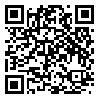Volume 8 - Pre-proof (Accepted manuscript)
pbp 2026, 8 - Pre-proof (Accepted manuscript): 0-0 |
Back to browse issues page
Download citation:
BibTeX | RIS | EndNote | Medlars | ProCite | Reference Manager | RefWorks
Send citation to:



BibTeX | RIS | EndNote | Medlars | ProCite | Reference Manager | RefWorks
Send citation to:
Neisari R, Abdi F. Herbal Dental Anesthetics: An Ethnobotanical Review. pbp 2026; 8
URL: http://pbp.medilam.ac.ir/article-1-329-en.html
URL: http://pbp.medilam.ac.ir/article-1-329-en.html
1- Department of Anesthesiology, Emam Khomeini Hospital , Urmia University of Medical Sciences, Urmia, Iran
2- PhD in Biochemistry, Post-doctorate in Food and Diabetes, Institute of Medical Science, University of Toronto, Canada ,f.abdi@mail.utoronto.ca
2- PhD in Biochemistry, Post-doctorate in Food and Diabetes, Institute of Medical Science, University of Toronto, Canada ,
Abstract: (752 Views)
Objective: Toothache is among the most common health issues worldwide, arising from causes such as dental caries, gingival inflammation, or other pathological conditions. Medicinal plants have long been used as analgesics or local anesthetics for dental pain in traditional medicine and ethnobotanical knowledge across cultures, including Iran. This study reviews ethnobotanical evidence in Iran regarding plants with dental anesthetic and analgesic properties, highlighting key species and exploring potential mechanisms of action. The goal is to integrate traditional and scientific knowledge to identify plants suitable for development into natural dental anesthetic products.
Methodology: A narrative review was conducted using reputable scientific sources. Systematic searches were performed in Persian and English across databases including Google Scholar, SID, Magiran, PubMed, and Scopus using the keywords “toothache,” “dental anesthesia,” “medicinal plants,” and “ethnobotany.” Inclusion criteria focused on plants explicitly cited in Iranian ethnobotanical sources for dental analgesic or anesthetic properties.
Results: Numerous plants were identified, including Syzygium aromaticum, Pistacia khinjuk, Cichorium intybus, Thymus vulgaris, Centaurea cyanus, Amygdalus scoparia, Eucalyptus spp., Scutellaria multicaulis, Biebersteinia multifida, Verbascum thapsus, Ruta graveolens, Grammosciadium platycarpum, Mentha pulegium, Echium amoenum, Plantago major, Celtis australis, Seidlitzia rosmarinus, Melissa officinalis, Dianthus orientalis, Amygdalus haussknechtii, Isatis raphanifolia, Cannabis sativa, Amygdalus lycioides, Daphne mucronata, Pistacia atlantica, Papaver dubium, Peganum harmala, Papaver somniferum, Mentha aquatica, Glycyrrhiza glabra, and Viola odorata. The family Caryophyllaceae was the most represented, with five species. Aerial parts were most commonly used, and the provinces of Ilam, Fars, and Lorestan reported the highest number of dental anesthetic plants.
Conclusion: The considerable diversity of medicinal plants with dental anesthetic properties in Iranian ethnobotanical sources highlights the potential of indigenous knowledge for natural dental remedy development. However, the paucity of clinical and pharmacological studies on efficacy, safety, and dosing underscores the need for further rigorous research. Integrating traditional knowledge with modern science could facilitate the development of effective, low-side-effect natural alternatives to conventional chemical anesthetics.

Methodology: A narrative review was conducted using reputable scientific sources. Systematic searches were performed in Persian and English across databases including Google Scholar, SID, Magiran, PubMed, and Scopus using the keywords “toothache,” “dental anesthesia,” “medicinal plants,” and “ethnobotany.” Inclusion criteria focused on plants explicitly cited in Iranian ethnobotanical sources for dental analgesic or anesthetic properties.
Results: Numerous plants were identified, including Syzygium aromaticum, Pistacia khinjuk, Cichorium intybus, Thymus vulgaris, Centaurea cyanus, Amygdalus scoparia, Eucalyptus spp., Scutellaria multicaulis, Biebersteinia multifida, Verbascum thapsus, Ruta graveolens, Grammosciadium platycarpum, Mentha pulegium, Echium amoenum, Plantago major, Celtis australis, Seidlitzia rosmarinus, Melissa officinalis, Dianthus orientalis, Amygdalus haussknechtii, Isatis raphanifolia, Cannabis sativa, Amygdalus lycioides, Daphne mucronata, Pistacia atlantica, Papaver dubium, Peganum harmala, Papaver somniferum, Mentha aquatica, Glycyrrhiza glabra, and Viola odorata. The family Caryophyllaceae was the most represented, with five species. Aerial parts were most commonly used, and the provinces of Ilam, Fars, and Lorestan reported the highest number of dental anesthetic plants.
Conclusion: The considerable diversity of medicinal plants with dental anesthetic properties in Iranian ethnobotanical sources highlights the potential of indigenous knowledge for natural dental remedy development. However, the paucity of clinical and pharmacological studies on efficacy, safety, and dosing underscores the need for further rigorous research. Integrating traditional knowledge with modern science could facilitate the development of effective, low-side-effect natural alternatives to conventional chemical anesthetics.

Keywords: Dental anesthesia, Medicinal plants, Toothache, Ethnobotany, Pain relief, Herbal anesthetics
Received: 2025/02/23 | Accepted: 2025/08/12 | Published: 2025/09/15
Send email to the article author
| Rights and permissions | |
 |
This work is licensed under a Creative Commons Attribution-NonCommercial 4.0 International License. |



